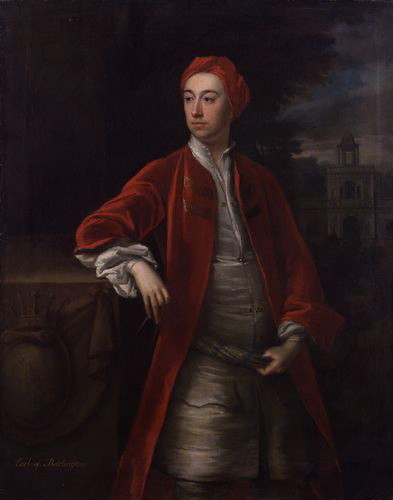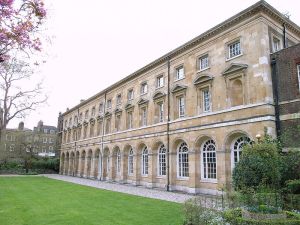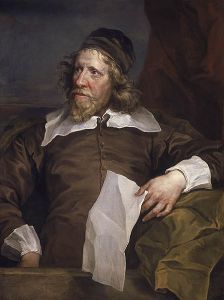Posts Tagged ‘earl of Burlington’
Richard Boyle, Third Earl of Burlington (1694-1753)
The Third Earl inherited the title and estates at the age of eleven after the death of his father, and by the age of 20 was a well established Whig aristocrat from the north of England.
He developed an interest in architecture and took a Grand Tour in 1719 to study the works of Palladio, armed with the reference books of Inigo Jones which he used for reference and note taking. Burlington was well-travelled. In all he took three Grand Tours between 1714-19 and other trips to Paris.
 On his return he appointed Colen Campbell, the other god father of the Palladian movement, to work on his London home in Piccadilly, Burlington House, now the home of the Royal Academy of Art.
On his return he appointed Colen Campbell, the other god father of the Palladian movement, to work on his London home in Piccadilly, Burlington House, now the home of the Royal Academy of Art.
By the mid 1720’s he had a new protegé in William Kent (1685-1748), a fellow Yorkshireman who he had met in Italy in 1719. Kent, initially a painter, lived at Burlington House. Kent was also asked to edit Burlington’s pet project, the publication of The Designs of Inigo Jones.
Burlington, an architect in his own right and often referred to as ‘the architect Earl‘, and ‘The Apollo of the Arts‘, for he was also a lover of music. He had Georg Frederic Handel dedicate two works to him whilst staying at Burlington House, and In 1719, was one of main subscribers in the Royal Academy of Music, which produced baroque opera for stage.
He was designer of some of the earliest and most important Palladian buildings including a Villa at Tottenham Park, Wiltshire (1721), a House for General Wade in Great Burlington Street, London (1723) and the New Assembly rooms in York (1731-2), and the Dormitory at Westminster School, London (1722 – 1730), the first public work by Burlington, for which Sir Christopher Wren had provided a design, which was rejected in favor of Burlington’s, a sign of changing English taste.
He also built another home of his own, Chiswick House, Middlesex. His architectural drawings, inherited by his son-in-law the Duke of Devonshire are preserved at Chatsworth, and enable attributions that would not otherwise be possible.
After the Assembly Rooms in York he designed few other buildings, and by 1740 was a semi-recluse living between Chiswick and Yorkshire. The Palladian Style he was ‘godfather’ of was however to flourish for many decades to come.
Burlington House
Burlington House located in Piccadilly is home to the Royal Academy of Arts and a number of Societies known as the Courtyard Societies. In relation to the London Grand Tour it is the history of the buildings that is of greater importance.
The original house was one of a number of very large private residences built on the north side of Piccadilly from the 1660s. Originally a red-brick mansion by Sir John Denham, it was sold unfinished in 1667 to Richard Boyle, 1st Earl of Burlington, after whom it is named.
In 1704 the house passed to the ten-year old Richard Boyle, 3rd Earl of Burlington, later known as “the architect earl” and “Apollo of the Arts”, he was to be the principal patron of the Palladian movement in Britain after three European Grand Tours 1714 – 1719, and a further trip to Paris in 1726. On his 1719 tour he carried his copy of Andrea Palladio’s book I Quattro Libri dell’Architettura with him as a reference and note-book.
Palladio and his books had been discovered a century earlier by the architect Inigo Jones, the first Grand Tourist, whose work the Earl would have known well; the Queens House in Greenwich (1719), the Banqueting House in Whitehall (1722) and Covent Carden (1730).
Jones had not executed many of his ideas and the Palladian style had not become a fashion until the Earl instigated the Georgian Palladian Revival when he retained Colen Campbell as architect for work on his own home, Burlington House. Campbell’s appointment in 1717/18, was a key moment in the history of English architecture. His work, in strict Palladian style, and the aesthetic preferences of Campbell, Burlington and their close associate William Kent, who also worked on Burlington House, turned the Palladian style into a dominant one for decades, and its influence can still be seen today.
On Lord Burlington’s death in 1753, Burlington House passed to the Dukes of Devonshire, but they had no need of it as they already owned Devonshire House just along Piccadilly. The 4th Duke’s younger son Lord George Cavendish and a Devonshire in-law, the 3rd Duke of Portland (namesake of the Portland Vase), each used the house for at least two separate spells. It then had a number of owners before being sold to the British government in 1854 for £140,000. In 1867 The Royal Academy of Art took over the main block on a 999 year lease with rent of £1 per year.
Burlington House will be visited on the London Grand Tour. Follow the link for tour reservations







